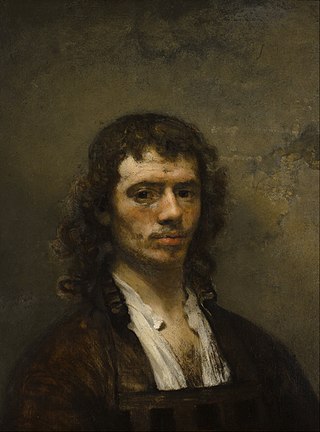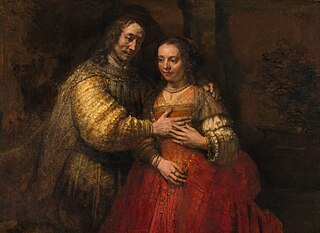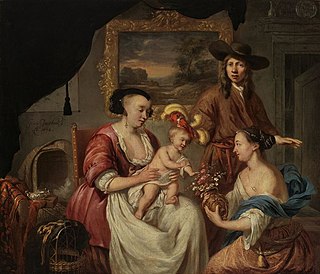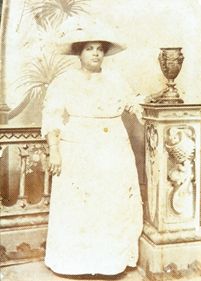
GovertTeuniszoon Flinck was a Dutch painter of the Dutch Golden Age.

Carel Pietersz. Fabritius was a Dutch painter. He was a pupil of Rembrandt and worked in his studio in Amsterdam. Fabritius, who was a member of the Delft School, developed his own artistic style and experimented with perspective and lighting. Among his works are A View of Delft, The Goldfinch (1654), and The Sentry (1654).

Thérèse Schwartze was a Dutch portrait painter.

Bartholomeus van der Helst was a Dutch painter. Considered to be one of the leading portrait painters of the Dutch Golden Age, his elegant portraits gained him the patronage of Amsterdam's elite as well as the Stadtholder's circle. Besides portraits, van der Helst painted a few genre pictures as well as some biblical scenes and mythological subjects.

Jan Six was an important cultural figure in the Dutch Golden Age.

The Jewish Bride is a painting by Rembrandt, painted around 1665‒1669.

Paulus Moreelse was a Dutch painter, mainly of portraits.
Jean Humbert de Superville was a Dutch painter of Swiss and French extraction. Humbert was primarily known as a portrait painter.

Jan Abrahamsz Beerstraaten or Johannes was a Dutch painter of marine art, particularly of events of the First Anglo-Dutch War and Dutch-Swedish War. Van Beerstraten depicted ports (Civitavecchia) and cityscapes of Amsterdam, as well as many cities and villages in the Netherlands. He captured castles, churches and other buildings that no longer exist.

Jan Verkolje or Johannes Verkolje was a Dutch painter, draughtsman and engraver. He is mainly known for his portraits and genre pieces of elegant couples in interiors and, to a lesser extent, for his religious and mythological compositions. He was a gifted mezzotint artist. Trained in Amsterdam, Verkolje spent his active professional career in Delft where he had access to powerful patrons.

Johannes Voorhout was a Dutch painter of history paintings, portraits and genre scenes. After training in the Dutch Republic he worked for a number of years in Hamburg before returning to work in Amsterdam.
Jacob Abrahamsz. Dissius was a Dutch typographer and printer. He inherited a collection of 21 of Johannes Vermeer's works, including The Milkmaid, Portrait of a Young Woman, A Girl Asleep, Woman Holding a Balance, and The Music Lesson. In 1680, he married Magdalena, daughter and sole heir of Vermeer's main patron Maria de Knuijt, her mother, with her father Pieter van Ruijven. Dissius died in 1695, and his collection was auctioned off in Amsterdam the following year.

Abraham George Ellis was a Dutch Vice Admiral and politician. Born in Suriname of a mother born in slavery, he was the first Minister of African descent to serve in a Dutch cabinet.

Nicolaes Hasselaer, was a Dutch Golden Age brewer and major of the Amsterdam schutterij, who is best known today for his portrait by Frans Hals.

Portrait of Abraham de Potter, Amsterdam Silk Merchant is a 1649 portrait painting of silk merchant Abraham de Potter by Carel Fabritius. The oil painting on canvas is 68.5 by 57 cm. The work has been in the collection of the Rijksmuseum in Amsterdam since 1892.

Augusta Cornelia Paulina Curiel (1873–1937) was a Surinamese photographer. She and her sister created an important record of life in the early twentieth century.

Abraham de Veer was a Dutch colonial administrator, who served as governor of Curaçao (1803–1804); the Dutch Gold Coast (1810–1816); Sint Eustatius, Saba and Sint Maarten (1817–1822); and Suriname (1822–1827).
Maria Vlier was a Dutch Surinamese teacher who wrote the first history textbook focused on the history of Suriname. Born into an intellectual family who descended from slaves, Vlier was educated in the Netherlands and returned to Suriname to teach. Recognizing that students were being taught European history and had no knowledge of the history of their own homeland, she wrote the first textbook on the colony. The book won a silver medal at the International Colonial and Export Exhibition of 1883 and was one of the three most-used textbooks in the Surinamese education system until 1945.
Surinamese nationality law is regulated by the 1987 Constitution, the Allocation Agreement of 1975, and the 2014 Surinamese Nationality Law. It is highly influenced by Dutch law. These statutes determine who is, or is eligible to be, a citizen of Suriname. The legal means to acquire nationality, formal membership in a nation, differ from the relationship of rights and obligations between a national and the nation, known as citizenship. Surinamese nationality is typically obtained either under the rules of jus sanguinis, i.e. birth to at least one parent with Surinamese nationality; or on the principle of jus soli, i.e. by birth in Suriname. It can also be granted to a permanent resident who has lived in Suriname for a given period of time or by presidential decree through naturalization.

Emma Kirchner was a German photographer who lived and worked in the Netherlands. She was the first, and for over 30 years, the only professional woman photographer working in Delft and the surrounding area.
















